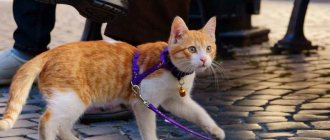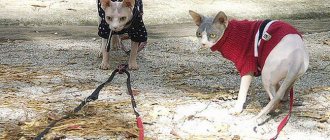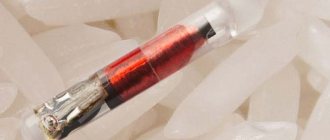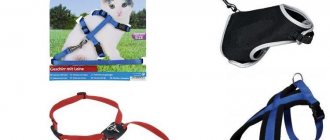A cat harness is a device for safe walks, an original accessory, and sometimes even stylish clothing for your pet. Curious and free-spirited by nature, she loves to explore new areas. But this animal, although predatory, is undoubtedly fragile, it is very easy to frighten, and the first instinct will be to run away and climb higher. It is in such cases that you need a strap so that you don’t have to remove your pet from the tree and at the same time protect it from street dangers.
What is a cat harness
A harness is an analogue of dog leashes adapted for cats, consisting of interlacing straps to completely envelop the body in the area of the shoulder blades. This device allows you to walk with your pets without fear of losing or injuring them. For cat lovers, this is an indispensable item that can be used in the following cases:
- while walking in the park, in the yard or in other crowded places;
- on trips to the veterinarian;
- during trips, transfers or travel;
- to participate in exhibitions and competitions.
But before you go to the store, you should know some of the design, selection and use features of such products.
Your comprehensive guide to the best cat harnesses, collars and leashes in 2021
Have you taken your cat for a walk lately? Agree, this is great!
If you have an indoor cat and want it to experience the joy of the outdoors without exposing it to injury or extreme weather conditions, it is a good idea to invest in a harness or leash for walking. We don’t recommend a collar, but more details in the article.
As dedicated cat lovers, we want the best for our furry friends. Recent trends have shown us that choosing the right cat harness or leash is not at all strange, but on the contrary, it can be a delightful way to show our pets the great views of the outdoors without having to worry about anything.
You can keep your cats healthy and alive with the right escape-proof harness, and just as importantly, you can enrich their lives with the same fun walks that dogs enjoy around the world.
Walking your cat can completely change the life of your feline friend. This is an enjoyable experience that every cat owner should experience at least once in their life.
In the end, you'll be able to test whether your cat likes or doesn't like being on a leash, but at least you can say that you gave her the opportunity.
Interested in keeping your kitten safe outside? Keep reading for a comprehensive guide to choosing the best cat harnesses and leashes on our market.
If you are looking for the perfect cat harness or leash, this list is for you. Read on for more information.
Harness for cats. What styles are suitable
It's common knowledge that dogs love walks, but did you know that some cats love walks too? If your kitten has shown interest in going outside, you should try a cat harness .
The best harness for your cat will depend on her age, body shape and preferences. You may have to try more than one model before you decide on your choice.
Cat harnesses can be made from nylon straps in the form of small leashes or can be small vests.
Figure Eight harness
A Figure 8 harness is a series of loops that secure around your cat in the shape of a number 8. These loops can put a lot of pressure on your pet, so keep in mind that this type of harness, like all harnesses, should be tailored to your cat's body size and behavior. cats.
For example, if your cat is anxious and giddy, this is not for her. In this case, you will need a vest, since a figure-of-eight harness will not only not protect your cat from escaping, it will simply begin to pull it into tight loops.
This type of harness has thin straps that will tighten if your cat reaches forward or tries to retreat.
One of the straps goes over the neck, across the back, and then under the chest. Typically secured with a simple quick release buckle and a D-ring on the back for space to attach a standard leash.
A figure-of-eight harness is a good choice if your cat is not prone to escape.
These harnesses are suitable for cats of all sizes, but should only be used in low-risk situations as they do not provide sufficient protection for your cat.
This is a great harness if you have a well-trained, calm cat.
Harness model “H-shaped”
This harness is best suited for calm, confident cats.
These harnesses benefit from an adjustable neck and girth for a good fit and added safety. They also include a D-ring to fit a leash.
The harness wraps around your cat's torso and fastens with a snap buckle. Typically they will have a strap on the torso in front of the forelimbs and a strap behind the forelimbs. There will also be straps connecting the two for reinforcement.
Harness in the form of a “vest”
Vests are aimed at comfort and safety. If you have a larger cat in your home, the vest is a reliable tool that, when used, will prevent damage to tissues or ligaments.
If you are considering a vest for purchase, know that it can be used as a harness if you have a nervous cat or a cat that doesn't respond well to walks.
The vest is easy to put on. Typically, it includes two or three buckles, each of which is attached under the neck and around the abdomen.
A vest-style harness is considered the safest option for cats. They improve your pet's comfort by making them less likely to slip out of the harness.
Vest style straps provide durability and comfort with a snug fit. They have a larger surface area with wider straps that minimize the chance of your cat getting caught or pinched.
Because they distribute weight and pressure evenly, they are great for walking stronger cats.
What to look for when choosing a harness
There are several features that you should consider before purchasing a harness for your cat. What you choose ultimately comes down to your cat's preferences.
Velcro or buckles
While Velcro can help you achieve the tightest possible seal to your cat's body, some cats are afraid of the sound Velcro makes.
The buckles can be fastened quickly, but you also need to adjust a few straps to make sure the strap fits correctly.
Harness design
Externally, the accessory looks like an interweaving of thin straps into which the cat's head and front paws are threaded. At the top at their intersection in the area of the shoulder blades there is a special ring for attaching the leash with a carabiner. This allows you to evenly distribute the load on the belts, avoiding discomfort for the animal. And the girth around the neck and under the paws prevents him from jumping out of them in an attempt to escape.
When choosing a harness model, there are some aspects to consider:
- fasteners and fastenings should be easy to unfasten and adjust, adjusting the device to the parameters of the pet;
- choose a material that is durable, soft and lightweight, preferably natural nylon or cotton, which does not cause discomfort;
- the optimal width of the straps is 10-15 mm, smaller ones will dig into fur and skin, and larger ones will hinder movement;
- To select the appropriate size, you need to insert two fingers between the product and the cat’s back.
How to make a harness for your pet yourself?
If for some reason you don’t have the opportunity to buy a harness, or you didn’t find the right size at the pet store, or you just like to do handicrafts, then you can make this useful accessory with your own hands. Knitting lovers can simply knit a product from threads or yarn (depending on the season), and those who love to sew can build a harness from any available material. Denim is ideal; it is soft, comfortable, durable and breathable. The main thing is to take the measurements correctly, remembering to place your finger so that the finished harness does not put pressure on your pet’s skin.
After this, you should cut out the necessary elements, leaving space for the seams, and connect them together. You can also make a leash with your own hands; there are several ways to do this, with and without rivets. A more detailed master class can always be found in abundance on the Internet. You will need the following tools: a thick “gypsy” needle, strong and durable threads, a large button or clasp, a metal ring for a carabiner and, of course, suitable material. The latter is at your request; it can be not only denim, but also any other equally durable fabric, such as nylon or soft leather. As a result, you will receive an exclusive harness for your pet.
Types of cat harnesses
There are many different designs of harnesses, but when grouped together there are four types:
- The figure eight is made in the form of two loops: one smaller to secure the neck, and the other, larger, to encircle the body behind the front legs. It is fastened on the shoulder blades, which makes it easier to use and reduces the cost of the product.
- The "H" type is very similar to the figure eight, having two straps. The main difference is that they are connected on the back with a straight jumper, which resembles the letter “H” when looking at the pet from above. It is suitable for large cats to compensate for the distance between the neck and the line of the back between the shoulder blades.
- The V-shaped also consists of two loops, but they are connected on the chest with an additional strap. This makes the harness look like a "V" when viewed from the front of the animal, or a "Y" when viewed from below.
- A harness-overall is included in the category of clothing, as it consists of a thick vest to which a rein is attached. It is suitable for fragile miniature pets, when there is a high risk of damaging their ribs with a careless jerk. Moreover, the jacket will warm you up during the cold season and protect your wool from dirt or water.
Classic harnesses
Such designs consist of three or four straps: the two main ones are fastened on the neck and chest, and the others connect them on the back and stomach. The leash is attached to the top of the harness using a special ring.
Popular models:
- Petsy with a leash. Colors: yellow, blue, pink, black, light green. Bust circumference – from 26 to 44 cm.
- Zoonik with a leash. Colors: yellow or red. It has a universal size, suitable for cats of medium build.
- TRIXIE 4185 with leash. Color red or blue. Suitable for cats whose chest circumference is 22-42 cm.
- Ferplast Fantasia P XXS. Different colors: elephants, brown patterns, pink stars, blue whales, multi-colored hearts, red and yellow circles, etc. Neck circumference – from 20 to 32 cm.
- Rogz Reflecto Cat S and XS with leash. Has a print in different colors: blue, green, black. Size S is suitable for cats with a chest volume of 24 to 40 cm. For kittens, size XS is intended (volume 20-30 cm).
- Hunter Sweet set with leash. Different colors: pink, orange, rainbow. Suitable for adult cats with a chest circumference of 23-38 cm.
- Lilli Pet M. Colors: blue, light blue, orange, green. Sizes from 18 to 28 cm.
Both the chest and neck straps are adjustable in length, so this accessory will suit cats of any size. The smallest models can be used for walking small kittens.
Make a cat harness with your own hands
The harness can be made at home, without going to pet stores. A hand-made accessory can be made from any material, taking into account all the parameters of the pet and the preferences of the owners. The technique for this is chosen based on one’s own capabilities and imagination. It can be:
- weaving an openwork or dense crocheted harness;
- knitting a warm product with knitting needles;
- joining leather or thick belts with an awl and a “gypsy” needle;
- making a jacket according to patterns with sewing fabric.
Before you start work, you need to take measurements with a centimeter tape:
- the neck circumference should be loose, with an addition of about 0.5-2 cm for allowances;
- covering the sternum behind the front legs in the area of the shoulder blades, so that two fingers can be placed between the belt and the body of the animal;
- the distance along the chest line from the intended collar to the strap behind the paws.
In accordance with these measurements, you can draw a diagram and cut out straps for a simple harness or a pattern for a full-fledged jacket. For this you can use old jeans, genuine leather, nylon, nylon, raincoat fabric. The leash can be attached to the body with a carabiner, a button and a rivet, or it can be sewn on initially. It is also worth stocking up on rings and clasps for fastening the elements of the product to each other. The individual parts should be sewn firmly so that the reins do not break at the most inopportune moment. And when using decorative elements, you need to be careful: they should not add weight, and must be securely fastened so that the pet does not accidentally bite off or swallow one of them.
Quick release harnesses
Such designs have only one clasp, which snaps onto the pet’s back. They are made from strong nylon.
Popular models:
- Ferplast Easy Easy Small. Available colors: red, brown, orange, black, blue, pink. Chest circumference – from 35 to 56 cm.
- Doo S. Color red. A special feature of the model is the presence of LEDs. Suitable for pets with a chest circumference of 30-42 cm. The width of the straps is 2 cm.
- Zoonic set with leash. Available colors: brown and green. Belt width – 1 cm.
- Saival classic XXS. Colors: red, yellow and black. Suitable for small cats or kittens with a chest circumference of 17 to 27 cm.
- TRIXIE Premium with leash. Purple harness, universal for all cats. Suitable for medium sized animals.
These models are very easy to use. They fasten quickly, are conveniently adjusted and eliminate the possibility of escape.
IMPORTANT! You should pay attention to the presence of a belt that goes between the front legs along the chest. Without such a strap, the cat's throat will be compressed.
When not to use a harness
Owners who love their pets can fork out for the most expensive accessory for them, or spend more than one hour creating an exclusive and one-of-a-kind walking device, watching dozens of master classes. But in order not to waste time and money, you should know in which cases the use of a harness is not recommended:
- It is better to walk cats over 10 years old who have not previously been accustomed to a leash without one, in uncrowded places;
- pregnant, unvaccinated or weak pets who have undergone surgery or illness have a high risk of catching the virus from street animals;
- in children whose immunity has not developed, such an experience can worsen their health;
- For an overly timid cat, using a harness will result in considerable stress, and for an aggressive cat, it will also result in unnecessary injuries.
Why does a cat need a harness?
Of course, free walks are preferable for a cat, but, unfortunately, this is not applicable everywhere. If you live in a rural area, you are unlikely to walk your cats on a leash. And in the private sector, cats have slightly different functions than just being pets. These are working animals whose direct duty is to catch mice, and doing this on a leash is quite difficult. If you live in a quiet city area in a small house with a cozy yard, where everyone knows each other, there are few cars, there are no inadequate sadistic neighbors who consider cats their personal enemies, it is quite acceptable to let the cat live a full cat life (but it’s up to you to decide, of course ).
Walking on a leash is justified if you live in a large multi-storey building, where it is difficult for a cat to get outside, and staying there is unsafe. There is no doubt that megacities with a lot of cars and paved local areas are not the best place for cat walks. Therefore, if you want your pet to go for walks, you cannot do without a leash, and therefore without a harness, since a collar for attaching a leash is absolutely not suitable for a cat, because in this case, when pulling, the main load falls on the animal’s neck, which may damage it. For cats, a mounting option is required on the back - on the shoulder blades or even lower.
In megacities, it is better for cats to walk under control
With supervised walks, you can be sure that your animal:
- will not get lost;
- will not eat any nasty things;
- will not be attacked by cruel people, aggressive relatives and dogs, annoying children;
- won't get hit by a car.
Under no circumstances should you leave your cat tied to a leash unattended, even on your own property or dacha. It is not uncommon for tethered cats to be torn to pieces by stray dogs that had made their way into the territory, and because of the tether they had no opportunity to escape or climb a tree.
Not all cats will benefit from walks (and therefore the use of a harness). You should not insist on walking if:
- your animal is under five months old: in this case, there is a high risk of catching some dangerous infection (this is also true for unvaccinated adults);
- you have a timid and nervous animal for which a walk would be too stressful;
- your pet has reached a respectable age, but has never gone outside: you shouldn’t even start - it will also be too much of a shock for him, let him live out his days in peace;
- your cat has had an illness or surgery;
- your cat is in heat or late in pregnancy.
In addition to walking, harnesses with a leash can be used when visiting the veterinarian, traveling in public transport or at exhibitions.
Instructions for use
Even though each purchased harness does not have step-by-step instructions for use, some rules can still be highlighted:
- a collar is fixed on the neck, and if it is missing, a smaller strap is put on so that the ring for the rein is on the back;
- the front paws are inserted into the second loop, for which the figure-of-eight straps are first loosened and then tightened back;
- the straps are tightened and checked to ensure that there are no twisted or too tight fastenings, and that the finger fits freely between the cat’s body and the strap;
- immediately before going outside, attach a leash, the ring to which should be located between the shoulder blades.
It is also easy to put on a vest, you need to stick the front paws through the holes, and then fasten it on the chest and fasten the reins. If you follow these instructions, owners will be able to avoid many problems with a walk or trip accompanied by a pet.
How to properly put a harness on a cat?
So, you purchased a harness for the first time, and now you are faced with the question: how to properly put a harness on a cat? At first, out of habit, it will be difficult for both you and your pet, but show maximum patience - and everything will work out. After all, a new product for a cat is an incomprehensible thing, and at first he will probably break free and try to escape. You should put the harness on the animal in stages, following the following instructions:
- Place the harness next to your pet - let him smell it, play with it and make sure that this previously unfamiliar design is not dangerous and will not cause him any harm.
- Take your pet in your arms, pet it, calm it down and talk to it tenderly.
- Then start putting on the harness. Place one loop around the neck with the carbine up (it should be on the back), and insert the animal’s paws into the second loop. If you bought a model with a clasp, then in this case the cat's paws are inserted into the loops one by one, the strap is adjusted under the belly, and the clasp is secured on the back.
- Check that you have not twisted anything and that everything is securely fastened. Make sure the harness does not put pressure on your pet's skin and adjust the straps if necessary.
- Fasten the leash to the carabiner ring - and the job is done, you can go for a walk.
If you have difficulty putting on a harness, you can use the Internet by searching for “how to put a harness on a cat video” and watch the instructions.
Mr. Cat recommends: how to train a cat to wear a harness
It is also important to properly accustom your pet to a harness. The optimal age for this is from 3 months to a year, when his immunity has formed, and everything new is perceived with the curiosity of a discoverer.
To help the kitten get used to the new accessory faster, you can offer it to your baby for play.
For an adult animal, training should begin differently:
- put the harness in his favorite place to give him time to explore and sniff the new object;
- put it on for walks around the house, motivating wearing the new thing with goodies and affection, and gradually letting him get used to the leash;
- adjust the length of the reins in advance to avoid unpleasant incidents on the street;
- For the first exit, choose a quiet place, bring the cat in your arms and let him sit on the ground, coming to his senses.
But if, once outside, the pet does not move, you should not pull it and force it to walk.
The first time a cat in a harness goes outside
Before we consider the question of how a cat's first walk should go, let's pay attention to four important reasons why pets should not be walked in a harness at all. Otherwise, nothing good will come of it.
- Kittens up to six months old. These little ones still have weak immunity and they can’t go outside yet.
- Older cats who have never seen the street before. Don't risk their health.
- Postoperative or postpartum period. The animal's body is not yet strong.
- Character traits. If your pet is overly aggressive or cowardly.
If your cat does not fall under any of these points, then you can begin to accustom your pet to the street. To begin with, choose some quiet courtyard, where there will be no large crowds of people and animals. The more secluded the place, the better. If there is no such place nearby, then it is better to carry the animal in your arms to the nearest public garden. There, carefully lower your pet to the ground and observe its behavior. In a new place, and even in an open space, the cat will behave warily and look around in fear. Don't bother her, let her look around and get used to it. Make sure that nothing scares her, otherwise this will discourage the animal from wanting to go for walks for a long time. Don't try to put pressure on your cat and force it to walk, you must follow it yourself. You must come to terms with the fact that it is your pet who is walking you, not you. Be patient, time will pass - and walks in the fresh air will begin to give him pleasure.
Advantages and disadvantages of harnesses
Like any product, a harness has its positive and negative sides. The first include:
- the opportunity to calmly and safely walk your pets in the fresh air, strengthening the immune system;
- simple design and reliable fastenings that do not allow the head to slip out;
- absolute control in public transport or crowded places;
- a large model range allows you to choose the most suitable accessory according to size and taste;
- sales are carried out in almost any pet store, in different price categories.
Among the disadvantages of helmets are:
- negative reaction of cats to restriction of freedom of movement in the first stages;
- the likelihood of poor-quality fastenings, seams and materials, due to which the pet can break free and run away;
- the need to change the accessory during growth, loss or weight gain, choosing the right size.
How to choose the right harness and cat leash
Choosing the right harness will allow you to quickly accustom your pet to it. If the cat doesn’t like the device, he will become aggressive, and there is even a risk of escape. Therefore, pay attention to the quality of the harness and the material from which it is made.
Material selection
It is safest to choose harnesses made from nylon and cotton fabrics with a felt lining. Firstly, they will not rub your pet’s neck, and secondly, they are very easy to care for. It is not recommended to buy leather harnesses, as this material is too rough for cats.
The cost of cat collars starts from 160 rubles. But it is better not to purchase a cheap product, since it is usually made in China and is of low quality. If you have a large, muscular pet, there is a high chance that he will simply tear the accessory.
If you want to purchase a branded harness, it will cost you 1000 rubles or more. Very often they are made from natural suede. The price corresponds to the quality, and the device will not fail for a long time.
Harness adjustment
To choose the right accessory, you need to know your pet's chest circumference and neck size. Pay attention to the following nuance. Two fingers should fit between the lower collar and the pet's belly. Then the harness can be considered securely fastened.
The harness straps should not be too narrow. The best option is a width of one to one and a half centimeters. More expensive accessories have adjustable straps. With their help, you can really adjust the ammunition without any problems.
When buying a harness, take a closer look at the leash, which can be of two types:
- regular (length up to two meters);
- roulette.
The latter allows cats to better explore the space around them.
It is important that the fastening materials are of high quality, otherwise they may break and the cat will be free, which poses a danger to him.
Cost of harnesses
The price of a harness may vary depending on the materials used in its manufacture, type and design, and brand. There are the following price categories:
- 100-200 rubles - the most budget option, made in a figure-eight or H-shape. These are artificial leather products from GLG, Triol, Lauron, Arkon, nylon from Trixie, Darell, Zoonik, nylon from Gamma, Pet Hobby.
- For 300-400 you can purchase harnesses that have a more complex design and advanced functionality. They are equipped with sliders for adjusting the length of the straps and chrome fittings. They are produced from nylon or leatherette by the same brands, as well as by the companies Camon, Dezzie, Nobby.
- A harness-vest made of soft nylon will cost 400-800. You can purchase such a product from the companies Triol, Ferplast JOGGING, IPTS, Trixie. The cost here depends on the design of the jacket and the fabric used, the material of the fasteners.
- Expensive ones include harnesses made of suede, corduroy, velvet, leather, produced by a well-known brand, or exclusive products with stylish decorative elements.
In general, you should choose harnesses for your pets, taking care of their comfort, as well as ease of assembly. After all, cats are freedom-loving animals, each with their own character, and few of them will agree to wait for a long time while slow owners put on or take off all the equipment. On the other hand, a quality reason will allow them to safely walk on the street, thereby improving the health and even the mood of the pets.
1111
Harnesses-vests
Such products look like a soft vest that covers half of the body. They are very comfortable for cats as there is no pressure from the straps. For their manufacture, soft porous fabric is used.
Popular models:
- Triol S with leash. Colors: brown, yellow, blue, crimson. The material is well ventilated, as it has small holes. Chest volume – 35 cm.
- Petkit AIR FLY S with soft lining. The harness has a perfect fit thanks to the unique 3D fit. The material is elastic, breathable, and has a reflective element. Suitable for large cats with a chest volume of 45-50 cm.
- Marvelous Dog S. Gray-pink color. The entire internal surface is made of soft mesh material. There are special adjustable straps, thanks to which you can adapt the harness to a specific animal. Bust circumference – 36-48 cm.
- Petkit Air Pro XS. Color dark gray. The model has an ideal and very comfortable shape. There is a foam padding sewn inside that has a shock-absorbing effect. There is also a reflective element. Chest circumference – 40-45 cm.
- Puppa Soft vest harness pro S. Colors: black, blue, light brown, khaki, yellow, green, orange, red, pink, dark blue, purple. The harness is made of breathable material. Suitable for small pets with chest volume from 30 to 32 cm.
This type of harness has a great advantage - if the size is chosen correctly, the cat will not be able to get out of it and run away.
INTERESTING! Some models are equipped with reflective tapes.
How to assemble and put on correctly?
Once the cat harness has been purchased, the most important thing left is to assemble it correctly and put it on the cat.
It’s worth noting right away that, out of habit, the pet will resist in every possible way at first and will not want to wear this accessory, so the owners will have to be patient, and everything will definitely work out.
The harness and leash are assembled according to the instructions included with the product. You should put the harness on your cat in stages, following the following recommendations.
- First of all, the product must be placed next to the pet. He will smell it, carefully examine it and make sure that the unfamiliar thing will not harm him. It's good if your pet plays with the harness for a while.
- Then you need to take the “fluffy” in your arms, calm it down, stroke it and talk to it tenderly, after which you can start putting the product on. First, you should put one of the loops around your neck (with the carbine up), and carefully insert the cat’s paws into the second loop. In the case when a model with a clasp is purchased, the pet’s paws must be inserted into the loops one by one, the strap under the belly should be adjusted and the clasp should be secured on the back.
It is important to make sure that everything is fastened securely and not twisted. In addition, you should make sure that the accessory does not put pressure on your pet’s skin; if necessary, additional adjustments are made on the straps.
- The process is completed by fastening the leash to the ring, after which you can safely go for a walk.
When should you not walk with a harness?
Almost all cats love to walk. But there are cases when the animal does not need to be taken outside on a harness.
In some cases, it is better not to take the cat outside
It is better to refrain from walking in the following situations:
- If your pet does not have the necessary vaccinations. This is especially true for small kittens that have not reached 5 months. Immunity does not develop immediately, so it is better to refrain from going outside for now. It is very easy to get an infection.
- Harness walks should be postponed if the cat has recently suffered a serious illness or surgery.
- An animal should not be taken out during estrus.
- Shy, unbalanced and nervous cats may never adapt to unfamiliar conditions, so it is better not to take such animals out for walks at all. When putting on a harness, sometimes they react extremely inappropriately. There will be little benefit from such promenades, because stressful situations negatively affect the general immune system and cause heart pathologies.
- Animals that are too aggressive are also not allowed outside, since fights are guaranteed in this case.
- It is better not to try to accustom an elderly pet over 10 years old who has never walked on a harness before to using this device. This can have a detrimental effect on the cat's health.
It is not recommended to take pregnant or lactating cats outside, as there is a risk of contracting infectious diseases. The immune system in this state is weakened and the body is more susceptible to various diseases.
Getting your cat used to a harness
It’s a rare cat who calmly accepts the design placed on it. Most often, the animal tries to get rid of an unfamiliar object that is bothering it. Therefore, you can start learning from a very early age.
The kitten must first be introduced to the harness and leash.
Small kittens usually get used to wearing a harness very easily. From the age of three months, babies gradually begin to learn. First, the pet is simply introduced to the accessory. To do this, the object is placed where the toys are or near the bowl. The item will be saturated with familiar odors and will not cause anxiety in the animal. After a couple of days, the harness can be put on the kitten for a short time. In this case, you should carefully and carefully tighten all the fasteners, the pet should be comfortable. Your fingers should fit freely under the straps. After 10–15 minutes, the product is removed.
What is the best way to use a cat leash?
Cat leashes are used with either a collar or a harness. Representatives of the cat family are freedom-loving animals by nature; therefore, when a person forces a pet to do something, for example, to walk on a leash, the pet can resist, at least at the first stage of getting used to walking on the street. Accordingly, the main disadvantage of a cat collar is that the four-legged dog can simply jump out of it while resisting the will of the owner. To prevent this from happening, the only way is to tighten the device, but this has a negative effect on the pet's blood flow. In addition, it will simply be uncomfortable for your furry friend to wear a collar and he will most likely associate it with punishment, which is very bad for the animal’s psychological balance.
An alternative option is a cat leash with a harness. Modern pet stores offer a wide variety of cat harnesses for every taste and color. There are cat harnesses with adjustable length. Their convenience lies in the fact that you can independently adjust the length according to the size of your pet; moreover, thin straps made of synthetic material or leather in the summer do not allow the pet to feel additional heat from wearing the device.
If the pet is overweight, or the cat is pregnant, or the pet is simply very active, then overalls harnesses are suitable for them, which, at the moment of tensioning the leash, evenly distribute the tension force over the entire surface of the animal’s body, as a result, the harness does not cut into the body and the pet will be more comfortable. It is comfortable to wear while walking.
On sale you can most often find three main types of harnesses according to their configuration: figure-eight, V-shaped and H-shaped.
- A figure-eight harness is worn around the animal's neck and body, and is shaped very much like the number eight. At the back there is a fastening ring through which a cat leash can be fastened with a carabiner. This structure of this walking device allows you to prevent slippage, which is observed with a cat collar, and distribute the load from the throat to the body during periods of strong tension on the leash.
- The H-shaped harness is shaped like the letter H, that is, the connecting rings have another additional fastening in the form of a jumper. This device reduces the strain on the neck.
- The V-shaped harness is shaped like the Latin letter V when viewed from the front. This unusual form of the device is convenient to put on the animal, and, like an H-shaped harness, it also allows you to reduce the load on the neck.
- Harness jacket - comes in H and V shapes. The advantage is that it protects your pet’s fur from contamination; in addition, insulated options are sold that allow you to take walks with your furry friend at any time of the year and in any weather.











